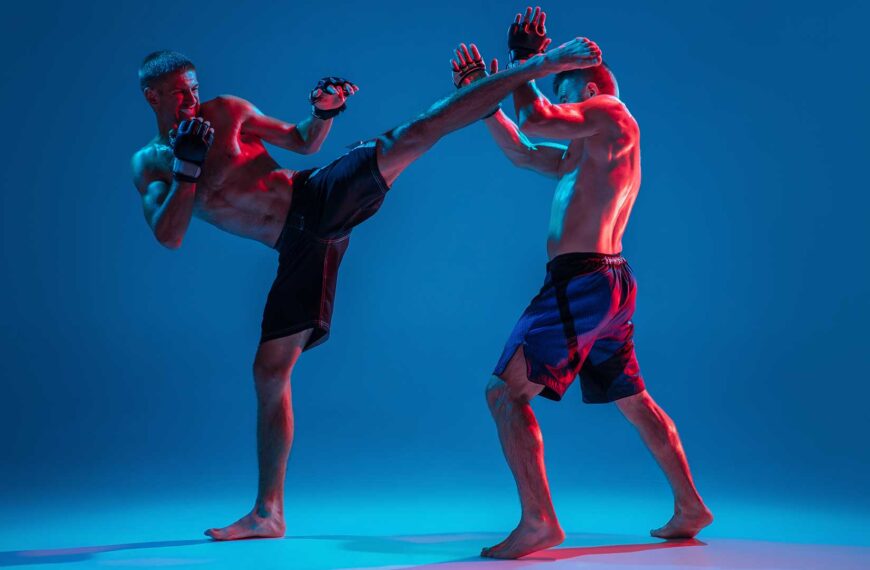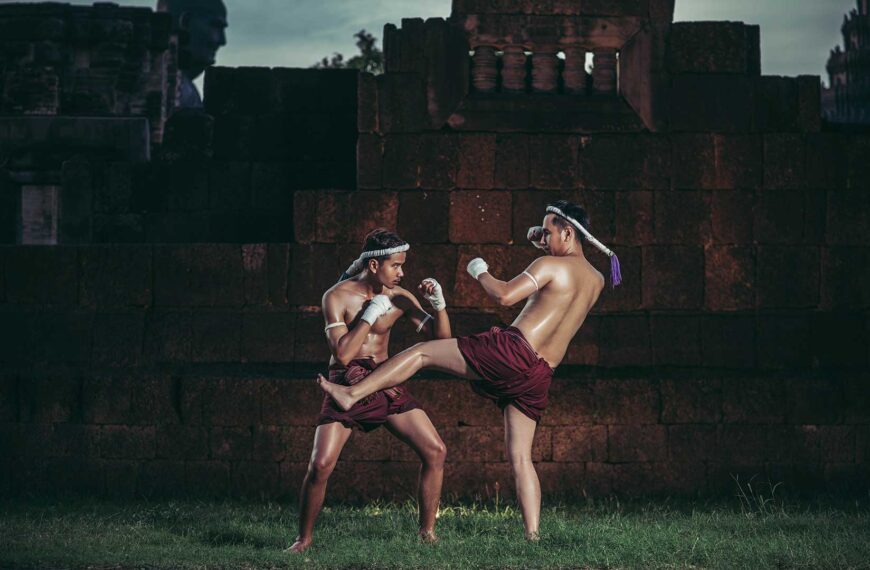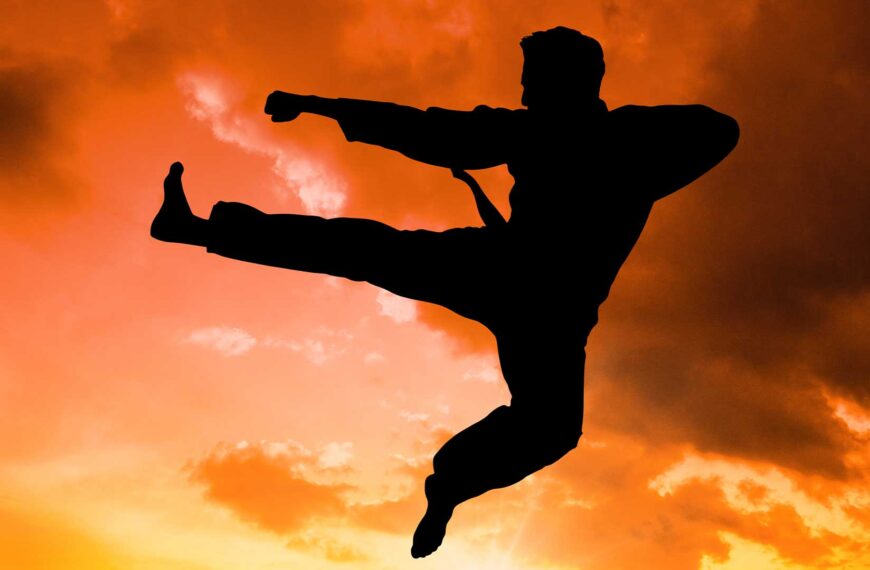What Readers Will Learn:
- How AI algorithms can be used to analyze performance data in Muay Thai training and fights, track key metrics, and provide real-time feedback and personalized training recommendations.
- The benefits of virtual training and simulation in Muay Thai, including the creation of immersive virtual environments, AI-controlled opponents, and the ability to train independently without physical sparring partners.
- The role of AI in biomechanical analysis and injury prevention in Muay Thai, including the use of motion capture technology to optimize techniques and detect and prevent injuries.
Can artificial intelligence (AI) revolutionize the world of Muay Thai, the popular kickboxing sport known as the art of eight limbs? In recent years, advancements in technology have transformed various industries, and martial arts is no exception. The integration of AI into Muay Thai has opened up new possibilities for training, performance analysis, strategy development, and injury prevention. In this article, we will explore the transformative potential of AI in the world of Muay Thai and how it can enhance the overall experience for practitioners and fighters.
Data Analysis and Performance Tracking
One of the key benefits of incorporating AI into Muay Thai is the ability to leverage AI algorithms to analyze performance data from training sessions and fights. AI can process vast amounts of data and extract valuable insights that help fighters and trainers optimize their performance. By tracking key metrics such as strikes thrown, accuracy, power, speed, and defensive techniques, AI can provide real-time feedback and personalized training recommendations.
For instance, AI algorithms can analyze video footage of fights and training sessions to identify areas for improvement. By pinpointing weaknesses and strengths, fighters can focus their training efforts on specific techniques and strategies. AI-powered performance tracking systems can also offer detailed reports on progress over time, allowing fighters to monitor their growth and make data-driven decisions.
To illustrate the impact of AI in this context, the Muay Thai Sangha School integrates Tai Chi Chuan into its training programs, emphasizing the significance of slow movements and internal energy work. This integration of internal martial arts highlights the importance of combining different approaches for personal growth and development [^1^].
| AI Application | Description |
|---|---|
| Data analysis and performance tracking | AI algorithms analyze performance data from training sessions and fights to provide real-time feedback and personalized training recommendations. |
| Virtual training and simulation | AI creates immersive virtual environments that simulate realistic training scenarios, allowing practitioners to train independently and receive real-time feedback and analysis. |
Virtual Training and Simulation
AI has made it possible to create immersive virtual environments that simulate realistic training scenarios for Muay Thai practitioners. Virtual training allows fighters to practice their techniques and strategies in a controlled and safe environment. AI-controlled opponents with varying skill levels can be incorporated, challenging fighters to improve their abilities and adapt to different fighting styles.
One of the significant advantages of virtual training is its accessibility. Practitioners can train independently, anytime and anywhere, without the need for physical sparring partners. This flexibility is especially beneficial for those who may not have access to training facilities or suitable training partners.
Furthermore, virtual training platforms can provide real-time feedback and analysis, helping fighters identify areas for improvement. By analyzing movement patterns and techniques, AI can offer personalized suggestions and corrections, enhancing the learning process and accelerating skill development.
Biomechanical Analysis and Injury Prevention
Biomechanics plays a crucial role in the effectiveness and efficiency of Muay Thai techniques. By leveraging AI-powered motion capture technology, practitioners can analyze and optimize their movements to maximize strike power, speed, and efficiency.
AI algorithms can detect flaws in technique and provide real-time feedback on how to correct them. This helps fighters refine their movements and minimize the risk of injury. By monitoring movement patterns, AI can identify potential areas of stress or strain on the body and suggest modifications to prevent injuries.
Moreover, AI-powered systems can track the overall health and well-being of fighters, helping them maintain peak physical condition. By analyzing data on factors such as heart rate, sleep patterns, and recovery rates, AI can provide personalized recommendations for rest, nutrition, and training adjustments.
Personalized Training Programs
Every fighter has unique goals, abilities, and weaknesses. AI can play a pivotal role in developing personalized training programs that cater to individual needs. By analyzing performance data and progress, AI-driven systems can adapt training regimens to ensure continuous improvement.
Machine learning algorithms can refine and optimize training programs over time, taking into account the specific strengths and weaknesses of each fighter. This personalized approach maximizes the effectiveness of training and helps fighters achieve their full potential.
Case Study: The Journey of Alex, a Muay Thai Fighter
Alex is a dedicated Muay Thai practitioner who has been training for several years. Despite his passion for the sport, he has always felt that he could benefit from more personalized training and feedback to elevate his performance to the next level.
One day, Alex’s coach introduced him to a new AI-powered training system that would revolutionize his training experience. The system utilized advanced algorithms to analyze performance data from Alex’s training and fights, tracking metrics such as strikes thrown, accuracy, power, speed, and defensive techniques.
With this real-time feedback, Alex was able to identify areas of improvement and receive personalized training recommendations tailored to his specific needs. The AI system helped him optimize his technique, refine his strikes, and enhance his defensive maneuvers. Alex was amazed at the precision and objectivity that the AI system brought to his training, allowing him to progress faster than ever before.
Furthermore, the system offered virtual training and simulation, allowing Alex to train in immersive environments that simulated real-life scenarios. AI-controlled opponents of varying skill levels challenged him to improve his abilities. This meant that even when physical sparring partners were unavailable, Alex could continue training independently, anytime and anywhere.
As Alex continued his journey, the AI system’s biomechanical analysis capabilities became invaluable in preventing injuries and optimizing his technique. By analyzing his movement patterns, the AI system could detect potential issues and provide corrective suggestions to enhance strike power, speed, and efficiency. Alex was able to make adjustments to his training techniques, reducing the risk of injuries and improving his overall performance.
With the help of AI, Alex’s training program became highly personalized. The AI system developed tailored training regimens based on his goals, abilities, and weaknesses. It continuously adapted the program based on his progress and feedback, ensuring that he was always on the path to improvement. The machine learning aspect of the system refined and optimized his training program over time, pushing him to new heights.
Alex’s journey also involved fight prediction and strategy development. The AI system analyzed past fights, predicting potential outcomes and assisting his trainer in formulating effective game plans based on opponent analysis. During fights, real-time analysis and recommendations helped Alex make tactical decisions that gave him an edge over his opponents.
In the unfortunate event of an injury, the AI system continued to support Alex’s journey. AI-powered tools and wearable devices monitored and analyzed his rehabilitation progress. Personalized recovery plans and exercises were provided to expedite the healing process. The system also identified patterns and suggested modifications to training techniques to prevent future injuries, ensuring that Alex could continue pursuing his passion with minimal setbacks.
Alex’s journey exemplifies the transformative potential of integrating AI into Muay Thai. With the help of AI algorithms, he was able to enhance his training, performance analysis, strategy development, and injury prevention. The combination of human skill and AI technology propelled him to new levels of success, and he continues to be excited about the ongoing advancements in the sport, thanks to AI.
Fight Prediction and Strategy
AI algorithms can analyze vast amounts of data from past fights and predict potential outcomes. This analysis assists trainers and fighters in formulating effective game plans and strategies based on opponent analysis. By identifying patterns and tendencies, AI can provide insights into an opponent’s strengths and weaknesses, allowing fighters to tailor their approach accordingly.
During fights, real-time analysis and recommendations from AI systems can enhance tactical decision-making. By analyzing the opponent’s movements and reactions, AI can provide suggestions on techniques and strategies that are likely to be effective. This real-time assistance can give fighters a competitive edge and increase their chances of success in the ring.
Injury Rehabilitation and Recovery
Injuries are an unfortunate reality in the world of combat sports. AI-powered tools and wearable devices can aid in monitoring and analyzing the rehabilitation progress of injured fighters. By collecting data on factors such as range of motion, muscle activity, and recovery rates, AI can provide personalized recovery plans and exercises to expedite the healing process.
Additionally, AI can identify patterns and suggest modifications to training techniques to prevent future injuries. By analyzing movement patterns, AI systems can detect potentially harmful movements or imbalances and recommend corrective measures. This proactive approach to injury prevention can significantly contribute to the longevity and overall well-being of fighters.
Conclusion
The integration of AI into Muay Thai has the potential to revolutionize the sport. From data analysis and performance tracking to virtual training and injury prevention, AI offers numerous benefits for fighters and practitioners. The ability to create personalized training programs, predict fight outcomes, and enhance tactical decision-making brings a new level of sophistication to the sport.
While the article provides a good overview of the potential benefits of AI in Muay Thai, it could be improved by including concrete examples of AI implementation, providing more insights into the integration of Tai Chi Chuan, and discussing potential limitations or challenges. As advancements in AI continue, we can expect even more exciting prospects for the future of Muay Thai. The transformative potential of AI in this dynamic martial art is undeniable, and it will undoubtedly shape the way fighters train, strategize, and perform. By embracing AI and harnessing its power, Muay Thai practitioners can unlock new levels of success and push the boundaries of their abilities.
References: [^1^]: T’ai Chi Chuan – Muay Thai Sangha [^2^]: Muay Thai Vector Illustration (AI)










